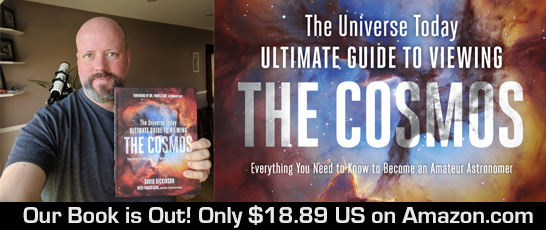NASA's James Webb Space Telescope is continuing to get tested, in preparation for its March 2021 launch to space. Engineers deployed the telescope's multi-layered sunshade, which will block the light from the Sun, Earth and Moon, allowing it to remain incredibly cold. With this test out of the way, there are a few more tests coming, and then it'll be shipped down to South America, in preparation for launch.
James Webb Tests its Sun-Shield. So Far, So Good.
Thanks!
Fraser Cain
Publisher
Universe Today
As always, if you have comments or questions, or suggestions on how I can improve this newsletter, please don't hesitate to reply this email or email me at info@universetoday.com.
Patrons, don't forget to login to Universe Today. That'll remove all the ads for you. Join the 833 Patrons who get our videos early, see behind the scenes, and get no ads on Universe Today.
Is Humanity Prepared To Discover Alien Life?
People always ask me how I think humanity will react if we discover life somewhere out there in the Universe, whether it's bacteria under the surface of Mars, a biosignature of alien life in the atmosphere of another world, or a radio signal from another civilization. Will our civilization lose its collective mind and have a temper tantrum on a global scale? Will we become one of those purge planets from Rick and Morty? Will the discovery suddenly end all religion, as we wait for guidance from our new alien overlords? Will we gather together as a species to present a common front to whatever cosmic horrors await us beyond the Solar System? In my opinion, if I could sum up the collective response in a single word, it would be: meh.
Subscribe to our podcasts:
Universe Today Guide to Space Audio: iTunes - RSS
Audio versions of all the media I upload to my YouTube channel, as well as bonus content, behind the scenes, interviews with Fraser and more
Astronomy Cast: iTunes - RSS
Your weekly facts-based journey through the cosmos, which I co-host with astronomer Dr. Pamela Gay. We have episodes on every concept in space and astronomy, from black holes to the history of astronomy.
Weekly Space Hangout: iTunes - RSS
A weekly round-up of all the breaking space news. Rocket launches, new discoveries from Hubble, and planetary science by three PhD astronomers... and me.
What Was The First Color In The Universe?
Just 300,000 years after the Big Bang, the Universe had finally cooled down to the point that light could escape into space. Today we call this the Cosmic Microwave Background Radiation, and the expansion of the Universe has red-shifted it into the microwave spectrum. But what did it look like back then? What color was the Universe near the beginning of time, and what color is it today?
Comets and Interstellar Objects Could be Exporting Earth Life Out into the Milky Way
There's this idea of Panspermia, that life could have traveled from world to world within the Solar System. But could there be a galactic Panspermia, where life could travel from star to star? Astronomers have proposed that Earth-grazing asteroids and comets could scrape up life from Earth's upper atmosphere and then carry it off to other stars.
The Most Massive Galaxies Spin More Than Twice as Fast as the Milky Way
The stars in the Milky Way are traveling around the galaxy at 220 km/s. But that's nothing compared to the speed that some of the largest galaxies in the Universe are turning at. These "super spiral galaxies" can rotate at up to 570 km/s, almost three times as fast. This means that these galaxies are surrounded in a vast halo of dark matter that acts like an anchor to hold the galaxy together while it spins so rapidly.
How Long is a Day on Venus? Astronomers Make Their Best Measurement Yet
Because it's obscured in thick clouds, Venus is a tricky planet to observe and measure how rapidly it turns on its axis. Astronomers have now done the most accurate measurement of Venus' rotation speed ever, using 29 years of Earth-based radar to measure it. They've calculated that the planet takes 243.0212 +- 0.0006 days to turn a full 360 degrees.
Evolution Tells Us We Might be the Only Intelligent Life in the Universe
It's that age-old question: are we alone in the Universe? Evolution has shown that it comes to the same results many times, with wings, eyes and other physical features. But there are some features that evolution only came up with once, like the bones of vertebrates or photosynthesis. Did complex life on Earth arise after an unlikely chain of evolutionary events?
Time-lapse Captured from the International Space Station
Here's a beautiful picture of Earth and the stars captured by NASA astronaut Christina Koch from the International Space Station. Cities are the pale yellow dotted streaks. The thinner streaks are fires in Africa. The white blobs are thunderstorms active over central Africa. And the long star trails are because the space station itself is rotating as it travels around the Earth.
A NASA Panel Says We Don't Need to be so Careful About Infecting Other Worlds
Humanity has been sending spacecraft to other worlds for decades now, and our methods of preventing contamination are just as old. We've learned a lot about how tough Earth life can be and what the risks are, and a new panel made a series of recommendations about how NASA should clean their spacecraft to prevent contamination of other worlds with Earth life and vice versa.
Now that Many Countries Have the Ability to Destroy Satellites, the US is Figuring Out Ways to Make Them More Armored
With India's recent antisatellite test throwing up a hail of orbital debris, the world's space powers are reckoning with the reality of antisatellite combat. Sandia National Laboratories recently started up a new 7-year campaign to develop various satellite protection systems. These include hardware to actually protect core functions of the satellite as well as ways to help a satellite automatically maneuver away from a threat.
How Flagstaff, Arizona, switched to LEDs without giving astronomers a headache
With the advent of LED lights, the skies are becoming more light-polluted for astronomers. A big part of this is the bluish color that these LED lights use. But the city of Flagstaff, Arizona, home of the Lowell Observatory, has been switching out their lights to a less polluting warm yellow color. And the city has gotten a designation from the International Dark Sky Association for their efforts.
Elon Musk Tweets with Starlink. Services Could be Available Next Year.
We've been covering the development of SpaceX's Starlink constellation, with its proposed tens of thousands of high-speed internet satellites. But Elon Musk demonstrated that it actually works this week, transmitting a simple tweet over Starlink. The company is planning to get initial service operational by mid-2020, and worldwide operations quickly after that.
A Private Company in China Plans to Launch Reusable Rockets by 2021
Now that SpaceX is demonstrating the advantage of reusable rockets making powered landings, everyone is racing to catch up. And a new company in China called i-Space is planning to have a prototype ready by 2021. The rocket is called Hyperbolic-2, and it should be capable of delivering 1.9 tonnes or payload to Low-Earth Orbit. And I'm sure this won't be the last one.
Astronomers See Strontium in the Kilonova Wreckage, Proof that Neutron Star Collisions Manufacture Heavy Elements in the Universe
It was long believed that heavier elements were formed in supernova explosions, but there was another theory that they come from colliding neutron stars. Astronomers announced the discovery of the heavy element Strontium in the aftermath of the 2017 kilonova explosion. In addition, this discovery helped prove that neutron stars really are made up of neutrons.
Other Interesting Space Stuff
- Messier 93 - the NGC 2447 Open Star Cluster
- VP Mike Pence talks up property rights as he opens international space conference
- 2019 had the smallest ozone hole on record. Although, warmer temperatures mostly drove the improvement
- Here's a classic spiral galaxy, NGC 4380, as captured by Hubble
- Starburst galaxies are created through mergers
- A new recycling device is going to the International Space Station
- Jeff Bezos announces the team of companies that will carry humans to the Moon in 2024
- 50 years after NASA discarded the wet workshop, a company aims to revive it
- Boeing and Airstream Show off Their New Astronaut Transport Vehicle: the Astrovan II
- Google and NASA are pretty sure they've actually got a quantum computer
- Astronomers see the wreckage from a collision between exoplanets
- New Horizons team pieces together the best images they have of Pluto's far side
- China is doing wind-tunnel tests of a reusable spaceplane prototype
- Landslides on Mars could have formed without ice
- Caterpillar wants to supply NASA with autonomous robots to build bases on the Moon
- A rocky planet was found in a triple star system
- How To Discover Wormholes By The Stars That Orbit Them
Amazing Astrophotography on @universetoday
Pickering's Triangle
This is a photograph of a region that you might not be familiar with. It's called Pickering's Triangle, and it was captured by @chucksastrophotography. It's actually a tiny part of the Veil Nebula, which is part of a remnant from an ancienct supernova explosion.
We have featured over 1,000 astrophotographers on our Instagram page, which has more than 186,000 followers. Want to do a takeover? Use the hashtag #universetoday and I'll check out your photos.
Find your way across the night sky. Choose a variety of astronomy gear. Follow the Moon and the planets. Find deep sky objects across the seasons in both hemispheres. Observe comets, asteroids, satellites and space stations. Learn to do astrophotography.
Get it on Amazon for only $18.89. Here are some other options.
|


